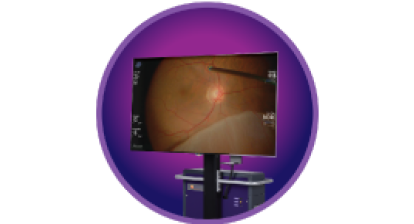
THIS IS STABILITY.
THIS IS THE HYPERVIT® DUAL BLADE VITRECTOMY PROBE.
Optimize performance with 20,000 cuts per minute.
ENGINEERED FOR CONTROL
More Cuts Per Minute For More Control Over Intraocular Surgical Procedures.1
When combined with CONSTELLATION® Vision System IOP compensation, the HYPERVIT® Dual Blade Vitrectomy Probe enables stable, closed-system intraocular surgery.
- 20 000 cuts per minute reduce pulsatile traction
- Dual-pneumatic drive powered by the CONSTELLATIONt Vision System increases vitreous flow
- Continuously open port reduces fluidic turbulence4
- Beveled tip design facilitates improved access to tissue plane5
*At similar single-blade flow rates using 25+®and 27+®gauge probes (n = 30 tests).
†At higher cut rates compared with traditional spring-return systems.
Related Products
Experience the complete Alcon vitreoretinal suite.


NGENUITY® 3D
VISUALIZATION SYSTEM
Real-time surgical feedback and immersive visualization on 1 screen


CONSTELLATION®
Vision System
The gold standard in vitreoretinal sugical platforms, designed for control


FINESSE® SHARKSKIN®
ILM Forceps
A texturized surface and conforming grasping platform designed to improve grip during ILM peeling6,7
DUAL-BLADE DESIGN WITH CONTINUOUSLY OPEN PORT REDUCES FLUIDIC TURBULENCE4,‡

MAXIMIZE 27+®GA PERFORMANCE


Vitreous Flow Rate
Continuously open port improves vitreous flow8


Peak Traction Force
20 000 cuts per minute observed to reduce pulsatile traction at similar single-blade flow rates1,2


Port-to-Surface Distance
Beveled tip design facilitates improved access to tissue plane5
§HYPERVIT® Dual Blade Vitrectomy Probe 27+®Ga compared at 20 000 CPM (maximum cut rate in core mode) with Advanced ULTRAVIT® Probe 27+® a at 10 000 CPM (maximum cut rate in core mode) and ULTRAVIT® Vitrectomy Probe 27+®Ga at 7500 CPM (maximum cut rate in core mode).
ıı 95% CI; n = 6 to 12 probes.
¶95% CI; n = 30 probes
MAXIMIZE 25+®GA PERFORMANCE


Vitreous Flow Rate
Continuously open port improves vitreous flow9


Peak Traction Force
20 000 cuts per minute observed to reduce pulsatile traction at similar single-blade flow rates2


Port-to-Surface Distance
Beveled tip design facilitates improved access to tissue plane5
#HYPERVIT® Dual Blade Vitrectomy Probe 25+®Ga compared at 20 000 CPM (maximum cut rate in core mode) with Advanced ULTRAVIT® Probe 25+®Ga at 10 000 CPM (maximum cut rate in core mode) and ULTRAVIT® Vitrectomy Probe 25+®Ga at 7500 CPM (maximum cut rate in core mode).
**95% CI; n = 8 probes.
‡95% CI; n = 30 probes.
HOW TO ORDER
To learn more about the HYPERVIT® Dual Blade Vitrectomy Probe from Alcon, contact your local sales representative.

PRODUCT VIDEOS
MIVS Important Product Information
Caution: Federal law restricts this device to sale by, or on the order of, a physician.
Indications for Use: The CONSTELLATION® Vision System is an ophthalmic microsurgical system that is indicated for both anterior segment (i.e., phacoemulsification and removal of cataracts) and posterior segment (i.e., vitreoretinal) ophthalmic surgery.
The ULTRAVIT® Vitrectomy Probe is indicated for vitreous cutting and aspiration, membrane cutting and aspiration, dissection of tissue and lens removal. The valved entry system is indicated for scleral incision, canulae for posterior instrument access and venting of valved cannulae. The infusion cannula is indicated for posterior segment infusion of liquid or gas.
Warnings and Precautions:
- The infusion cannula is contraindicated for use of oil infusion.
- Attach only Alcon supplied products to console and cassette luer fittings. Improper usage or assembly could result in a potentially hazardous condition for the patient. Mismatch of surgical components and use of settings not specifically adjusted for a particular combination of surgical components may affect system performance and create a patient hazard. Do not connect surgical components to the patient's intravenous connections.
- Each surgical equipment/component combination may require specific surgical setting adjustments. Ensure that appropriate system settings are used with each product combination. Prior to initial use, contact your Alcon sales representative for in-service information.
- Care should be taken when inserting sharp instruments through the valve of the Valved Trocar Cannula. Cutting instrument such as vitreous cutters should not be actuated during insertion or removal to avoid cutting the valve membrane. Use the Valved Cannula Vent to vent fluids or gases as needed during injection of viscous oils or heavy liquids.
- Visually confirm that adequate air and liquid infusion flow occurs prior to attachment of infusion cannula to the eye.
- Ensure proper placement of trocar cannulas to prevent sub-retinal infusion.
- Leaking sclerotomies may lead to post operative hypotony.
- Vitreous traction has been known to create retinal tears and retinal detachments.
- Minimize light intensity and duration of exposure to the retina to reduce the risk of retinal photic injury.
ATTENTION: Please refer to the CONSTELLATION® Vision System Operators Manual for a complete listing of indications, warnings and precautions.
- Alcon data on file, June 2018.
- Alcon data on file, June 2018.
- Riemann CD, Zhou J, Buboltz DC. Vitreous cutter velocities: dual pneumatic drive vs. single pneumatic drive with spring return probes. Poster presented at: 2011 Annual Meeting of the Association for Research in Vision and Ophthalmology; May 5, 2011; Fort Lauderdale, FL.
- Irannejad A, Tambat S, Abulon DJK. Retropulsion and mass flow of 27-gauge vitrectomy probes: comparison of dual-blade/flat-tipped probes and single-blade/beveled probes. Poster presented at: 18th Congress of the European Society of Retina Specialists; September 20–23, 2018; Vienna, Austria.
- Alcon data on file, May 2017.
- Alcon data on file, May 2018.
- Alcon data on file, September 2017.
- Alcon data on file, June 2018.
- Alcon data on file, June 2018.
©2021 Alcon Inc. 12/21 US-HV-2100019






